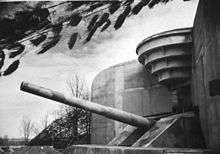Todt Battery
The Todt Battery, also known as Batterie Todt, is a battery of coastal artillery built by the Germans in World War II, located in the hamlet of Haringzelle, Audinghen, near Cape Gris Nez, Pas de Calais, France. It was part of the Atlantic Wall, and consisted of four Krupp 380-millimetre (15 in) guns with a range up to 55.7 kilometres (34.6 mi), capable of reaching the British coast, each protected by a bunker of reinforced concrete.
| Todt Battery | |
|---|---|
| Part of the Atlantic Wall | |
| Haringzelle, Audinghen, Pas de Calais, France | |
 The Todt Battery in 2008 | |
.svg.png) .svg.png) Kriegsmarine Ensign | |
| Site information | |
| Open to the public | One casemate is open to the public |
| Condition | Four casemates, in varied condition |
| Site history | |
| Built | 1942 |
| Built by | Organisation Todt |
| In use | 1942-44 |
| Materials | Concrete and steel |
| Battles/wars | Operation Undergo |
| Garrison information | |
| Garrison | |
History
The coastal defense version of the SK C/34 was modified with a larger chamber for coast defense duties to handle the increased amount of propellant used for the special long-range Siegfried shells.[1][2] Gander and Chamberlain quote a weight of only 105.3 tonnes (103.6 long tons; 116.1 short tons) for these guns, presumably accounting for the extra volume of the enlarged chamber.[3] An armored single mount, the Bettungsschiessgerüst (Firing platform) C/39 was used by these guns. It had a maximum elevation of 60° and could traverse up to 360°, depending on the emplacement. The C/39 mount had two compartments; the upper housed the guns and their loading equipment, while the lower contained the ammunition hoists, their motors, and the elevation and traverse motors. The mount was fully powered and had an underground magazine.[4] Normally these were placed in open concrete barbettes, relying on their armor, but Hitler thought that there was not enough protection for Battery Todt and ordered a concrete casemate 3.5 metres (11 ft) thick built over and around the mounts. This had the unfortunate effect of limiting their traverse to 120°.[5] Other C/39 mounts were installed at the Hanstholm fortress in Denmark, and the Vara fortress in Kristiansand, Norway. Plans were made to install two of these mounts at Cap de la Hague and two at Paimpol in France, modifying guns originally intended for an abortive refit of Gneisenau, but were not executed for unknown reasons. Work on putting two more mounts at Oxsby in Denmark was well advanced but incomplete by the end of the war.
The battery fired its first shell on 20 January 1942, although it was only officially opened in February 1942 in the presence of high Kriegsmarine dignitaries. Originally to be called Siegfried Battery, it was renamed in honour of the German engineer Fritz Todt, creator of the Todt Organisation and responsible for the construction of the Atlantic Wall, who died in a plane crash days before the battery's inauguration.
The battery was taken by Anglo-Canadian troops in September 1944, after an intense aerial bombardment, as part of Operation Undergo.
Museum
One of the four casemates now houses a museum about World War II, Musée du Mur de l'Atlantique. The exhibits include military hardware, including, outside, one of two surviving Krupp K5 artillery rail-mounted cannon.
Gallery
 A German soldier at the Todt Battery during World War II
A German soldier at the Todt Battery during World War II One of the battery's 38 cm guns during World War II.
One of the battery's 38 cm guns during World War II.
%2C_Audinghen_01_09.jpg) K5 28 cm railway gun breech, at the museum.
K5 28 cm railway gun breech, at the museum. Another view of the Todt Battery
Another view of the Todt Battery Bunker in 1993.
Bunker in 1993. Bunker housing the museum.
Bunker housing the museum. Diorama showing the battery's four bunkers.
Diorama showing the battery's four bunkers.
References
Notes
- http://www.navweaps.com/Weapons/WNGER_15-52_skc34.htm Chamber volume increased from 19,467 in3 (319 dm3) to 22,072 in3 (361.7 dm3), rifling length reduced from 629.2 in. (15.982 m) to 620 in (15.748 m)
- Campbell, p. 229
- Gander and Chamberlain, p. 272
- Hogg, p. 242
- Gander and Chamberlain, p. 256
Bibliography
- This article was created from the translation of the article Batterie Todt the French Wikipedia, licensed under the Creative Commons Attribution Share Alike 3.0 Unported and free documentation license GNU.
Further reading
External links
- Todt Battery Museum website (in French)
- Battery Todt on Bunkersite.com
- Germany 38 cm (14.96") SK C/34 (NavWeps page)